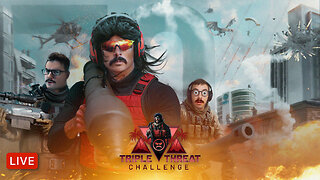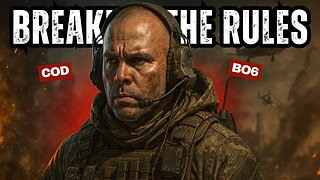Premium Only Content

❤️ ( My Ajumma ) Handmade Burger, Fried Egg Cheeseburger - Korean Street Food
Team Spirit was a Joint Military Training Exercise of United States Forces Korea and the Military of South Korea held between 1974 and 1993.
Ajumma / Middle-Aged Woman
Ajumma (Korean: 아줌마), sometimes spelled ajoomma, is a Korean word for a married, or middle-aged woman. It comes from the Korean word Ajumeoni (Korean: 아주머니). Although it is sometimes translated "aunt", it does not actually refer to a close family relationship.
I use to work at the JSA / 38 North around UFL "Ulchi Focus Lens,”
A Brief History of the US-ROK Combined Military Exercises
Credits to Author COL Robert Collins
The militaries of every country conduct field and command post exercises to test their ability to perform missions dictated by their national leadership. Because three countries conduct such exercises regularly, numbering nearly two million soldiers in close proximity, the Korean peninsula experiences a heightened level of exercises—and tensions—that few other regions or countries share. Since the end of the Korean War, two antithetically opposed halves of one Korean nation have stood ready to attack or defend over a limited, mountainous terrain with massive armies with distinctly different capabilities and with the potential of killing hundreds of thousands of civilians in the early stages of a conflict.
For the Republic of Korea (ROK) and the United States, conducting exercises has required overcoming political, cultural, doctrinal and philosophical differences since the end of the Korean War to meet the North Korean threat from a combined posture. The history of US-ROK exercises is dominated by the evolution of the bilateral military relationship and this enduring threat, inter-Korean relations, and US-DPRK relations. The base justification for these combined exercises are the ROK-US Mutual Defense Treaty and the fact that the Korean peninsula remains in a state of war due to the signing of an Armistice Agreement in 1953 and not a peace treaty.
Historical developments have dictated four distinct phases of military exercises and their political-military context on the Korean peninsula: the early phase lasting from the end of the Korean War to 1965; the “Second Korean War” phase of 1966-75; the expanded capabilities phase of 1976-91; and the asymmetric capabilities phase from 1992 to the present. The one constant in all four is the continued conduct by North Korea of annual winter training exercises, offensive in nature, that culminate in the early spring and bring the North’s military readiness to its maximum level for that year.[1]
US-ROK exercises have both military and political intent. They, of course, are intended to test their preparedness and the ally’s ability to conduct specific missions—in this case, to counter North Korean military adventurism. But there is also a political message for Pyongyang, namely that the alliance is prepared to protect the state, people and territory of the Republic of Korea and their combined interests while employing all the elements of national power to do so.
The Early Phase
The alliance’s combined exercises are a direct result of the “Pusan Letter” of July 7, 1950, presented by then South Korean President Rhee Syngman to General Douglas MacArthur, that passed operational control of ROK military forces for defense against North Korea’s attack starting on June 25, 1950.[2] Then the Commander-in-Chief of US Far East Command, General MacArthur, passed operational control to his other command position, head of the newly established United Nations Command (UNC).[3] After the war ended with the armistice, the UNC Commander retained operational control of South Korean forces, thus compelling alliance exercises to be combined, though not precluding national exercises designed to maintain unit readiness at lower levels. After the signing of the Armistice, the US began a steady drawdown of forces and the South Korean military began to rebuild and reconstitute under a moribund economy that limited its capabilities.
The early development phase was characterized by the ideological clash of communism vs. anti-communism, economic recovery that was initially more successful in the North than in the South, political instability in the South, and force-building on both sides. The first ROK-US combined exercise took place 16 months after the end of the Korean War in November 1955. The ROK Army 5th Corps and the US 5th Air Force conducted Exercise “Chugi,” or “Autumn Season,” under the supervision of the Tokyo-based US Far East Command, which supervised the UNC until 1957. Another exercise followed, designated “Spring Shower” and the two set the precedent for combined exercises that still exists today. Subsequent joint exercises, “Counterblow” and “Strong Shield,”[4] focused on interoperability and command relations between the two militaries, maintaining a basic readiness posture and conducting counter-insurgency operations.
-
 10:46:42
10:46:42
Rallied
13 hours ago $13.15 earnedWarzone Challenges w/ Doc & Bob
193K4 -
 3:26:25
3:26:25
Joe Donuts Live
6 hours ago🟢 Lost in Space with My Clones: The Alters Adventure Begins
32K4 -
 7:20:22
7:20:22
Dr Disrespect
15 hours ago🔴LIVE - DR DISRESPECT - TRIPLE THREAT CHALLENGE - WINNING AT EVERYTHING
217K12 -
 2:35:33
2:35:33
Chrono
7 hours agoBirthday-eve Stream | Helldivers II
27.7K1 -
 54:40
54:40
BonginoReport
1 day agoLABOR DAY SPECIAL! The Best of Nightly Scroll - Nightly Scroll w/ Hayley Caronia (Ep.124)
134K15 -
 2:39:21
2:39:21
Joker Effect
5 hours agoReviewing the downfall of Kick Streaming. Kick streamers welcome to Rumble! Stake bombshell found!
36.9K1 -
 1:06:10
1:06:10
Russell Brand
15 hours agoThe Greatest Lie Ever Told? - SF625
100K117 -
 3:25:13
3:25:13
elwolfpr
7 hours agoBlack Ops 6: Rise of the Relentless
14.2K1 -

Phyxicx
6 hours agoChillin - For The King - 9/1/2025
10.5K -
 LIVE
LIVE
Spartan
11 hours agoNew Game+ on E33, then back to Halo Grind
33 watching